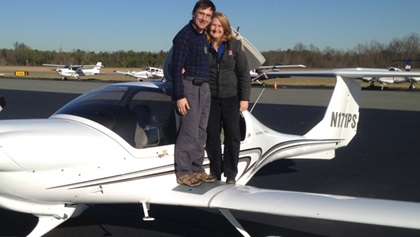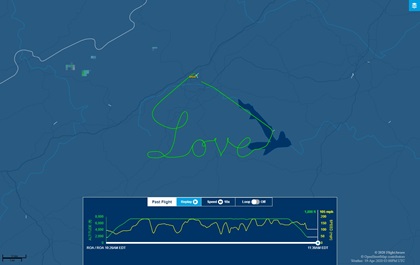Hopeful flights to nowhere
You’ve heard of skywriting before, perhaps even skytyping, but let me highlight a slightly different form of skywriting.
Many pilots know about FlightAware and use it to do everything from tracking an airline flight to seeing how true their course really was. (Did I hold that ATC-assigned altitude to within 100 feet? Uh oh!)
Rick’s father was a Boeing B–17 Flying Fortress navigator during World War II and later belonged to a flying club, so Rick grew up with a passion for aviation. As is the case with many of us, life got in the way of flying, but he’s managed to amass some 1,400 hours of flight time over the past 13 years, most of it in the Diamond DA40.
While trying to find ways to fly without putting others at risk, Betty suggested they look for ways to encourage the local community. Combining the goals of encouragement and flying, Rick plotted some waypoints to form the basics of each word, and then programmed those waypoints into the Garmin G1000 in his DA40.

“How hard can it be?” you may ask yourself. Well, sure, if you’re staying in the general vicinity of your home airport and you’re familiar with air traffic control, the surrounding areas, emergency landing fields, and landmarks. But when planning his first flight for the word “HOPE,” Rick found that the total round-trip flight would be 350 nautical miles and take several hours, so he decided to shrink his letters. Rick set off to write his first words, but approaching weather hindered his efforts. Instead, he made a practice flight to see if his plan would be feasible before he headed back to Roanoke-Blacksburg Regional Airport/Woodrum Field ahead of the weather.
“I do think ahead of time about how to connect the letters and the path I’ll fly to create them. But I didn’t think about which way to make the sharp turns until I was up there, and the winds aloft really played into that,” Rick said of his practice flight. “When I finally did write ‘HOPE’ the next weekend, the wind at 7,500’ was out of the [northwest] at 45 [knots], which made keeping on track pretty challenging, and it messed up some of my turns pretty badly. Honestly, that is why I decided to try ‘Love’ in cursive the following week—it’s more flowing and not as many sharp turns to deal with (easier to cover up mistakes!).

Still think it’s easy? Get this: Rick also gave some pireps due to the turbulence in the area while maintaining an arrow-straight flight path. Those 9-mile-long letters also spanned the ATC boundary between the Roanoke airport and Washington Center, creating what Rick called “a coordination issue for the one Roanoke departure controller.”
Rick initially planned to fly again the weekend of April 25, but low ceilings kept him grounded—something every pilot is all too familiar with. He joked, “I can’t even begin to imagine how I would file an IFR flight plan for one of these messages!”
Interested to know what Rick and Betty’s next message will be? I could tell you, but it would ruin the surprise. Their next will be “a tribute to all the health care workers, first responders, and other essential workers who are still out there keeping the rest of us alive and safe.” Let’s just say you may want to do a search for N171PS the first weekend in May, so long as the weather in Roanoke cooperates.




